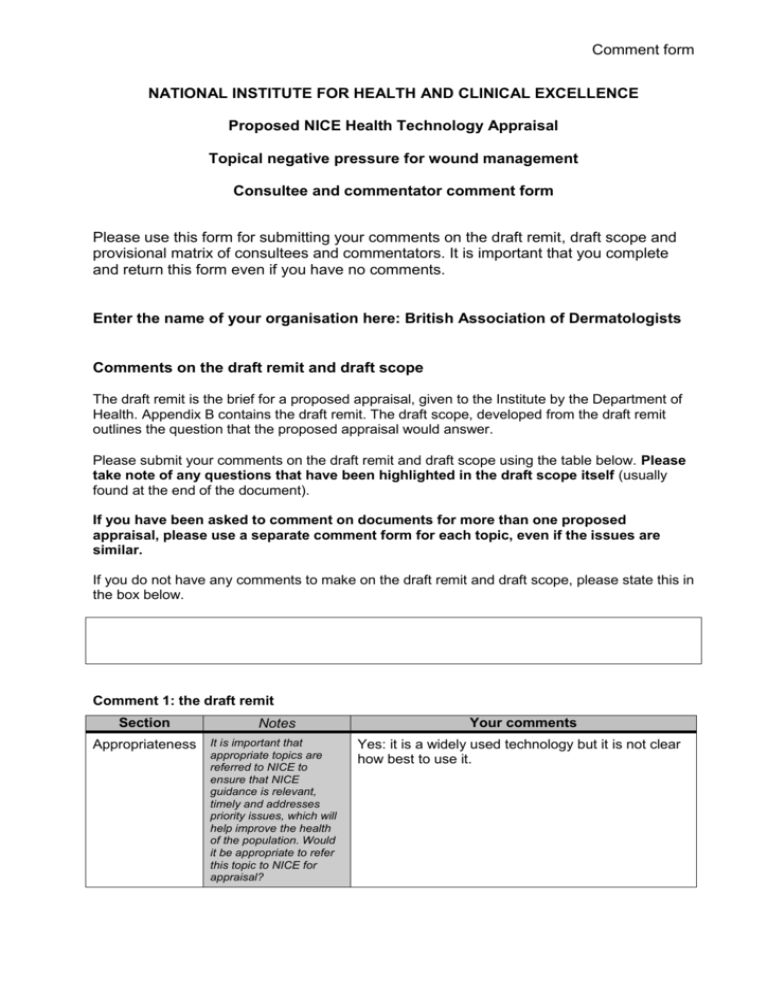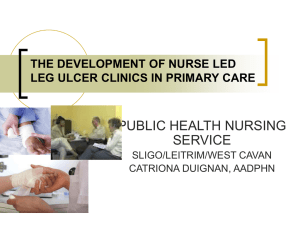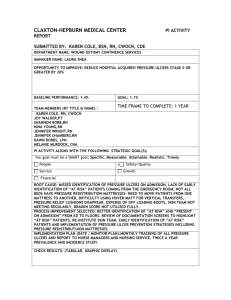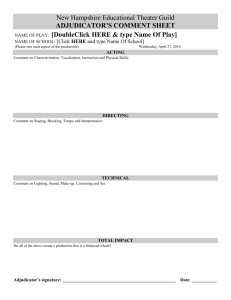Topical negative pressure for wound management
advertisement

Comment form NATIONAL INSTITUTE FOR HEALTH AND CLINICAL EXCELLENCE Proposed NICE Health Technology Appraisal Topical negative pressure for wound management Consultee and commentator comment form Please use this form for submitting your comments on the draft remit, draft scope and provisional matrix of consultees and commentators. It is important that you complete and return this form even if you have no comments. Enter the name of your organisation here: British Association of Dermatologists Comments on the draft remit and draft scope The draft remit is the brief for a proposed appraisal, given to the Institute by the Department of Health. Appendix B contains the draft remit. The draft scope, developed from the draft remit outlines the question that the proposed appraisal would answer. Please submit your comments on the draft remit and draft scope using the table below. Please take note of any questions that have been highlighted in the draft scope itself (usually found at the end of the document). If you have been asked to comment on documents for more than one proposed appraisal, please use a separate comment form for each topic, even if the issues are similar. If you do not have any comments to make on the draft remit and draft scope, please state this in the box below. Comment 1: the draft remit Section Notes Appropriateness It is important that appropriate topics are referred to NICE to ensure that NICE guidance is relevant, timely and addresses priority issues, which will help improve the health of the population. Would it be appropriate to refer this topic to NICE for appraisal? Your comments Yes: it is a widely used technology but it is not clear how best to use it. Comment form Section Your comments Notes Wording Does the wording of the remit reflect the issue(s) of clinical and cost effectiveness about this technology or technologies that NICE should consider? If not, please suggest alternative wording. Satisfactory Timing Issues What is the relative urgency of this proposed appraisal to the NHS? Is the suggested timing for submission of evidence (see cover letter) appropriate? Satisfactory Any additional comments on the draft remit Comment 2: the draft scope Section Your comments Notes Background information Consider the accuracy and completeness of this information. Appropriate The technology/ intervention Is the description of the technology or technologies accurate? Yes Population Is the population defined appropriately? Are there groups within this population that should be considered separately? Although wounds of different aetiologies are put together in trials they should be assessed separately. Comparators Is this (are these) the standard treatment(s) currently used in the NHS with which the technology should be compared? Can this (one of these) be described as ‘best alternative care’? Important to make sure that for some conditions the fundamental care has been given, eg compression bandaging for venous leg ulcers, pressure relief / offload for pressure ulcers and diabetic foot ulcers. Outcomes Will these outcome measures capture the most important health related benefits (and harms) of the technology? Time to healing is often used as a marker for wound healing but has some limitations in view of wounds being of different sizes at start of any intervention. Changes in pain useful in terms of immediate benefit to patients. Economic analysis Comments on aspects such as the appropriate time horizon. Appropriate Comment form Section Your comments Notes Suggestions for additional Other considerations issues to be covered by the proposed appraisal are welcome. None Comment form Section Questions for consultation Your comments Notes Please answer any of the questions for consultation if not covered in the above sections. If appropriate, please include comments on the proposed process this appraisal will follow (please note any changes made to the process are likely to result in changes to the planned time lines). For which types of wound should this technology be appraised? Of these, which have the highest priority for appraisal? Acute traumatic wounds with complications, eg associated bone fractures Some evidence suggesting that use of vacpump can reduce the length of stay / number of surgical procedures required for patients with compound fractures. Dehisced surgical wounds Vacpump therapy seems very helpful in improving dehisced surgical wounds but does it reduce length of stay significantly. Pressure ulcers Pressure ulcers classically put into “chronic wound “ group but in fact an acute wound which can take time to heal, especially if pressure relief not optimal. Vacpump therapy seems to help but true value over other factors such as proper pressure relief, nutrition not clear. Chronic wounds, eg venous leg ulcer Still not clear why some ulcers are slow to heal despite adequate treatment. Vacpump therapy probably not helpful in those which appear to heal but value of vacpump in the “hard to heal” group not clear Diabetic foot ulcers Range of pathophysiologic factors complicates issues here; with rise in incidence of neuroischaemic ulcers over just neuropathic or ischaemic ulcers it would be useful to know the value of vacpump therapy in different groups. Others – vacpump may be helpful in rarer causes of ulceration, eg sickle cell; evidence is likely to be lacking in this heterogeneous group If priority needed suggest Diabetic foot ulcers – ischaemic vs neuropathic vs neuroischaemic pressure ulcers dehisced surgical wounds venous leg ulcers What constitutes standard management for these types of wound? Diabetic foot ulcers (neuropathic) pressure relief (orthotic off loading) dressing any ischemic component needs vascular assessment / treatment Pressure ulcers pressure relief with mattress nursing care, eg turning nutrition dressing skin care, eg protection from incontinence Dehisced surgical wounds treatment of infection debridement dressing choice Venous leg ulcer compression therapy (correct for size of leg) dressing choice intermittent pneumatic compression Comment form Section Notes Your comments Any additional comments on the draft scope Comment 3: provisional matrix of consultees and commentators The provisional matrix of consultees and commentators (Appendix C) is a list of organisations that we have identified as being appropriate to participate in this proposed appraisal. If you have any comments on this list, please submit them in the box below. As NICE is committed to promoting equality and eliminating unlawful discrimination we are keen to know if we have missed any important organisations from the lists contained within the matrix and which organisations we should include who have a particular focus on relevant equality issues. If you do not have any comments to make on the provisional matrix of consultees and commentators, please cross this box: Comments on the provisional matrix of consultees and commentators Please include British Association of Dermatologists as consultees. Comment 4: regulatory issues (for manufacturers to complete) Section Notes Remit Does the wording of the remit reflect the current or proposed marketing authorisation? If not, please suggest alternative wording. Current or proposed marketing authorisation What are the current indications for the technology? What are the planned indications for the technology? FOR EACH PLANNED INDICATION: What is the target date (mm/yyyy) for regulatory submission? Which regulatory process are you following? Your comments Comment form Section Notes Your comments What is the anticipated date (mm/yyyy) of CHMP positive opinion (if applicable) and regulatory approval? Please indicate whether the information you provide concerning the proposed marketing authorisation is in the public domain and if not when it can be released. All commercial in confidence information must be highlighted and underlined. Please return this form, preferably by e-mail, to Jenniffer.Alty@nice.org.uk by 22 October 2007. Where email is not possible, please copy this completed form onto a CD-ROM and send to: Jenniffer Alty, Project Manager, NICE, MidCity Place, 71 High Holborn, London, WC1V 6NA to arrive on or before the deadline. Further contact details are ( 0161 209 3439; email: jenniffer.alty@nice.org.uk; fax 0207 061 9848).





